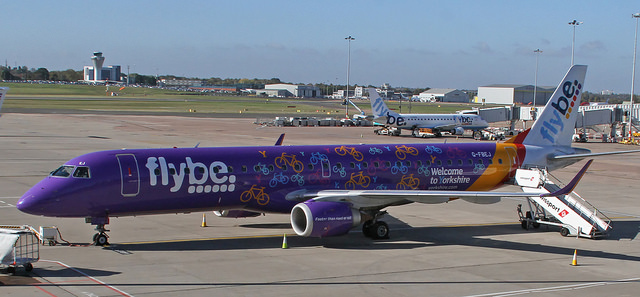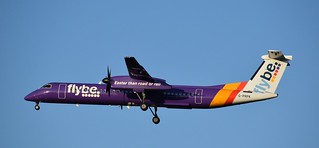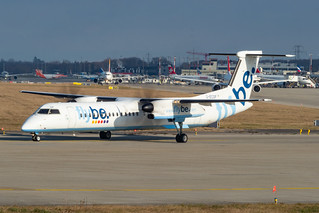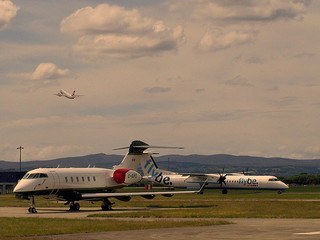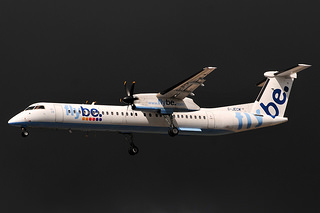Flybe DH8D at Newquay on Nov 14th 2019, aileron cable broke
Last Update: October 15, 2020 / 16:24:25 GMT/Zulu time
Incident Facts
Date of incident
Nov 14, 2019
Classification
Report
Airline
Flybe
Flight number
BE-2187
Departure
Newquay, United Kingdom
Destination
London Heathrow, United Kingdom
Aircraft Registration
G-FLBE
Aircraft Type
De Havilland Dash 8 (400)
ICAO Type Designator
DH8D
The UK AAIB released their bulletin for now concluding:
The most probable reason for the aileron cable breaking was that its strength had reduced as a result of wear leading to the failure of individual wires within the cable. The cable failed where it passed over a pulley on the rear wing spar where dirt accumulates which can penetrate into the strands and form an abrasive compound. This can accelerate the normal rate of cable wear. Post-modification cables are available which have a sleeve fitted over the susceptible section to prevent the ingress of dirt. The investigation established that the inspection procedure in the AMM would not have detected the damage to individual wires that run inside the cable.
The unresponsive right aileron on G-FLBE was not causal to this serious incident. As the operator ceased trading before they could establish the cause on G-FLBE, and other aircraft in their fleet, further investigation is required to determine if there is a wider safety issue.
Filters applied to some of the flight control parameters recorded on the FDR can affect the reconstruction of the rapid movement of the controls. Such filters are not permitted to be installed on the DHC-8-400 aircraft registered in the USA, but there is no similar requirement on aircraft registered in Europe or the UK. While this did not affect this investigation, this could affect other safety investigations.
The AAIB reported following the flight an inspection revealed "that the lower left aileron cable broke just outboard of the engine where it passed over a pulley to accommodate a change in the wing dihedral (Figure 1). There was no other damage to the aircraft."
The AAIB reported the captain had perceived the touchdown into Newquay as firm and was concerned it could constitute a hard landing, therefore involved maintenance. The flight data were checked via the wireless Quick Access Recorder and an engineer was dispatched to the aircraft to examine the aircraft. Maintenance subsequently informed the captain that the landing had been within limits and released the aircraft, that departed for Heathrow with a delay of about 25 minutes.
The AAIB reported: "Transport Canada analysed the FDR data from this event and concluded that ‘more than adequate control authority was available to the crew for continued safe flight and landing following the cable disconnect’. The number of reported in-service arisings was within the certification requirements for a Minor event and they considered the manufacturer’s proposed changes to the maintenance of the cables to provide adequate mitigation. They confirmed that the severity classification of Minor, which was applied during certification, remained appropriate." and continued (using the term handwheel for the control wheel):
During this investigation an issue, unrelated to the cable failure, was identified with the movement of the right aileron in-flight. Data from the FDR showed that shortly after G-FLBE levelled at FL200, the aileron stopped responding to movement of the handwheels. This lasted for about five minutes, with the aileron remaining in an almost fixed position of +5°. During this period, the AP continued to maintain wings level with handwheel positions between 13° CW and 27° CW. The inboard spoilers continued to operate normally during the flight.
As the aircraft started its descent to Exeter, the movement of the aileron suddenly returned to normal. This coincided with the handwheels being moved by the AP from 27° CW to 35° CW as the aircraft rolled out of a left turn.
Analysis of the FDR data from G-FLBE showed that the right aileron had previously stopped responding to the position of the handwheels during 14 of the previous 23 flights. Durations varied from between two and thirty-five minutes.
The aileron typically became unresponsive as the aircraft approached the top of climb or was in the cruise. There was, however, one flight where the aileron was unresponsive during descent from FL100 to FL060. The movement of the aileron always returned to normal prior to the aircraft starting the final approach. Normal operation of the aileron often coincided with movement of the handwheel as the aircraft entered a turn.
During the three flights prior to the incident flight, the right aileron was unresponsive for periods of 25, 35 and 26 minutes respectively. For the flights prior to these three, there was more variation in the duration that the right aileron was unresponsive.
The operator’s Flight Data Monitoring department subsequently analysed data from its fleet of DHC-8-400 aircraft to identify if the right aileron was unresponsive on other aircraft.
Initially 32 flights from 16 aircraft were reviewed and during half of these the right aileron was unresponsive for periods during flight. The review was extended to 51 aircraft for seven days flying during February 2020 and after the aileron cables had been replaced and tensioned on G-FLBE. The review looked for periods when the right aileron remained unresponsive to handwheel movement for more than 60 seconds. The results were:
- Thirty-six out of fifty-one aircraft had unresponsive ailerons.
- Twelve of the aircraft with an unresponsive aileron had an occurrence rate of 25% or more.
- The fleet leader was G-FLBE with a rate of 64% (21 events during 33 flights).
The operator had scheduled work on G-FLBE to isolate the cause of the unresponsive right aileron but ceased trading prior to this being concluded.
The AAIB analysed:
Effect of the aileron cable breaking
The failure (break) of the aileron control cable affected the position of the left aileron, which caused the aircraft to roll to the left. This was corrected by the pilot and AP providing a correcting input which displaced the handwheel from its normal neutral position. The amount of displacement varied at different stages of the flight due to a combination of the aircraft speed and roll control being assisted by the outboard spoiler: the spoiler becomes active below 165 kt.
The manufacturer was aware of three other events where a broken aileron cable was detected in-flight. As part of this investigation the Regulator and Manufacturer reviewed the risk resulting from the failure of an aileron cable and confirmed that such a failure had a Severity Classification of Minor.
Pilots response to the event
The pilots noticed the effect of the cable break shortly after departing Newquay where the wind was close to the aircraft’s crosswind limits of 32 kt. They reviewed the QRH but did not consider any of the checklists to be relevant. Therefore, they carried out a threat assessment and mitigated the risk of flying with a reduced handwheel range of movement by diverting to Exeter where the crosswind was not as strong. The aircraft made an uneventful landing.
An aileron cable breaking in level flight would initially cause an uncommanded roll and the most relevant QRH non-normal checklist was ‘Roll Control Malfunction’, which has the precondition ‘Aircraft rolls with no control wheel [handwheel] input’. However, the pilots did not recognise the relevance of this checklist, possibly because the AP was engaged and would have automatically countered the uncommanded roll to the left.
Cable failure
The lower left aileron cable failed due to a combination of internal and external wear. Following the failure, the tension in the upper cable would have caused the aileron to deflect upwards inducing a roll to the left. From the FDR data, it was established that the cable failed between the aircraft landing at Newquay and during the subsequent takeoff.
The landing at Newquay, which was close to the limit for classification as a heavy landing, would not have caused a serviceable cable to fail; however, the aileron cable was worn and its load carrying capability would have been reduced. It is, therefore, possible that the cable failed during the landing.
If the failure had occurred during the landing, then the pilot might have noticed that the aileron was at an unusual angle20 during the pre-flight external inspection. However, the inspection was carried out at night, in gusty, showery conditions which might make it more difficult to notice the unusual angle of the aileron.
The failure of the aileron cable would have had no significant effect on the force required to operate the handwheels, and the aileron position is not displayed in the cockpit. Consequently, the pilots could not have detected the failure if it had occurred after the external inspection had been completed.
Cable wear and possible causes
The aileron and spoiler cables are known to be susceptible to wear in the areas where they are redirected by pulleys to accommodate the change in the wing dihedral. The manufacturer published their first advice to operators in 2004 and modified cables with a polymer coating were introduced in 2015. The modification was not mandatory and while the operator was in the process of modifying their fleet, the new cables had not been fitted to G-FLBE.
The manufacturer identified low tension, vibration and contamination as the main causal factors for wear in control cables.
Incident Facts
Date of incident
Nov 14, 2019
Classification
Report
Airline
Flybe
Flight number
BE-2187
Departure
Newquay, United Kingdom
Destination
London Heathrow, United Kingdom
Aircraft Registration
G-FLBE
Aircraft Type
De Havilland Dash 8 (400)
ICAO Type Designator
DH8D
This article is published under license from Avherald.com. © of text by Avherald.com.
Article source
You can read 2 more free articles without a subscription.
Subscribe now and continue reading without any limits!
Read unlimited articles and receive our daily update briefing. Gain better insights into what is happening in commercial aviation safety.
Send tip
Support AeroInside by sending a small tip amount.
Related articles
Flybe DH8D near La Rochelle on Aug 5th 2016, hydraulic leak
A Flybe de Havilland Dash 8-400, registration G-FLBE performing flight BE-1583 from Southampton,EN (UK) to Palma Mallorca,SP (Spain), was enroute at…
Flybe E195 at Exeter on Feb 28th 2019, rejected takeoff due to haze on board as result of maintenannce prompts evacuation
A Flybe Embraer ERJ-195, registration G-FBEJ performing flight BE-4321 from Exeter,EN (UK) to Alicante,SP (Spain) with 100 passengers and 5 crew, had…
Flybe DH8D near BIrmingham on Jul 22nd 2019, cabin pressure problems
A Flybe de Havilland Dash 8-400, registration G-PRPK performing flight BE-1331 from Edinburgh,SC to London City,EN (UK) with 56 passenges and 4 crew,…
Flybe DH8D near Manchester on Nov 22nd 2019, engine shut down in flight
A Flybe de Havilland Dash 8-400, registration G-ECOF performing flight BE-774 from Southampton,EN to Edinburgh,SC (UK) with 69 people on board, was…
Flybe DH8D near Exeter on Nov 15th 2018, altitude disagree
A Flybe de Havilland Dash 8-400, registration G-JECR performing flight BE-3501 from Exeter,EN (UK) to Paris Charles de Gaulle (France), was enroute…
Flybe DH8D near Birmingham on Oct 13th 2019, sparking toilet
A Flybe de Havilland Dash 8-400, registration G-JECM performing flight BE-1544 from East Midlands,EN to Jersey,CI (UK) with 59 people on board, was…
Newest articles
THY B773 at Tokyo on Apr 20th 2024, approached wrong runway
A THY Turkish Airlines Boeing 777-300, registration TC-JJT performing flight TK-198 from Istanbul (Turkey) to Tokyo Haneda (Japan), was cleared to…
PSA CRJ9 at Charlotte on Apr 22nd 2024, odour in cabin
A PSA Airlines Canadair CRJ-900 on behalf of American Airlines, registration N633NN performing flight AA-5304 from Charlotte,NC to Chattanooga,TN…
Subscribe today
Are you researching aviation incidents? Get access to AeroInside Insights, unlimited read access and receive the daily newsletter.
Pick your plan and subscribePartner

A new way to document and demonstrate airworthiness compliance and aircraft value. Find out more.

ELITE Simulation Solutions is a leading global provider of Flight Simulation Training Devices, IFR training software as well as flight controls and related services. Find out more.

Your regulation partner, specialists in aviation safety and compliance; providing training, auditing, and consultancy services. Find out more.
AeroInside Blog
Popular aircraft
Airbus A320Boeing 737-800
Boeing 737-800 MAX
Popular airlines
American AirlinesUnited
Delta
Air Canada
Lufthansa
British Airways





